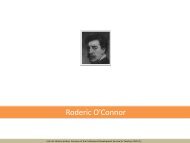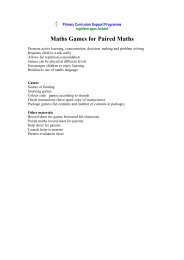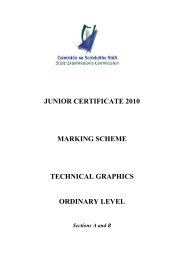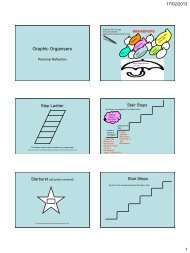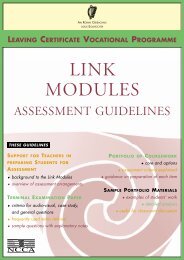What is Four in Balance? - PDST
What is Four in Balance? - PDST
What is Four in Balance? - PDST
You also want an ePaper? Increase the reach of your titles
YUMPU automatically turns print PDFs into web optimized ePapers that Google loves.
2 - Benefits of us<strong>in</strong>g ICTThere have been only a few studies <strong>in</strong>to such tools. Because many of theapplications are still <strong>in</strong> the draw<strong>in</strong>g board stage, the po<strong>in</strong>t of the research<strong>is</strong> usually to come up with a work<strong>in</strong>g design. As for research <strong>in</strong>vestigat<strong>in</strong>gthe applications’ benefits, the results have so far been ambiguous. Oneexperiment <strong>in</strong> which pupils used a digital video camera to produce theirown school news program did not demonstrably improve their knowledgeor skills (Luyten, 2011e). Neither did the use of digital portfolios produceany demonstrable benefits (see for example the study <strong>in</strong>to digitalportfolios <strong>in</strong> Meijer, 2009 or the study by Van Gennip, 2009), although thatcould be because the digital portfolios studied were not entirely functionalyet. In addition, the learn<strong>in</strong>g objectives for these applications are notalways clearly def<strong>in</strong>ed, mak<strong>in</strong>g it difficult to assess their effects.Computer-supported collaborative learn<strong>in</strong>gWillemsen asked teachers to consider five situations <strong>in</strong> which pupils wereengaged <strong>in</strong> computer-supported collaborative learn<strong>in</strong>g (CSCL), rang<strong>in</strong>gfrom relatively simple arrangements where pupils sat down together at acomputer to more complex arrangements where pupils collaborated whileeach one was at home work<strong>in</strong>g on h<strong>is</strong> or her own computer. Teachersdoubted whether such applications would be effective; they felt they didnot have enough control over the learn<strong>in</strong>g situation and did not see CSCLas be<strong>in</strong>g of equal value to a normal lesson situation (Willemsen, 2010).2.7 Summary• ICT can make teach<strong>in</strong>g/learn<strong>in</strong>g more efficient, more effective, and more<strong>in</strong>terest<strong>in</strong>g. Whether it <strong>in</strong> fact does so depends on how well the teacher<strong>is</strong> able to l<strong>in</strong>k the subject matter, the ICT application, and the pupil.• ICT has generally been found to produce greater results when usedfor knowledge transfer (<strong>in</strong>struction, practice) than for knowledgeconstruction (<strong>in</strong>quiry-based learn<strong>in</strong>g and learn<strong>in</strong>g to learn). In termsof the knowledge pyramid, many of the applications <strong>in</strong>tended forknowledge construction have not gone beyond the <strong>in</strong>spiration andex<strong>is</strong>tence stages. Applications <strong>in</strong>tended for knowledge transfer are morelikely to reach the perceived benefits and evidence stages. However,the benefits may be easier to perceive because the learn<strong>in</strong>g objectivesassociated with knowledge transfer are more clearly def<strong>in</strong>ed andbecause there are more proven assessment <strong>in</strong>struments available.31



